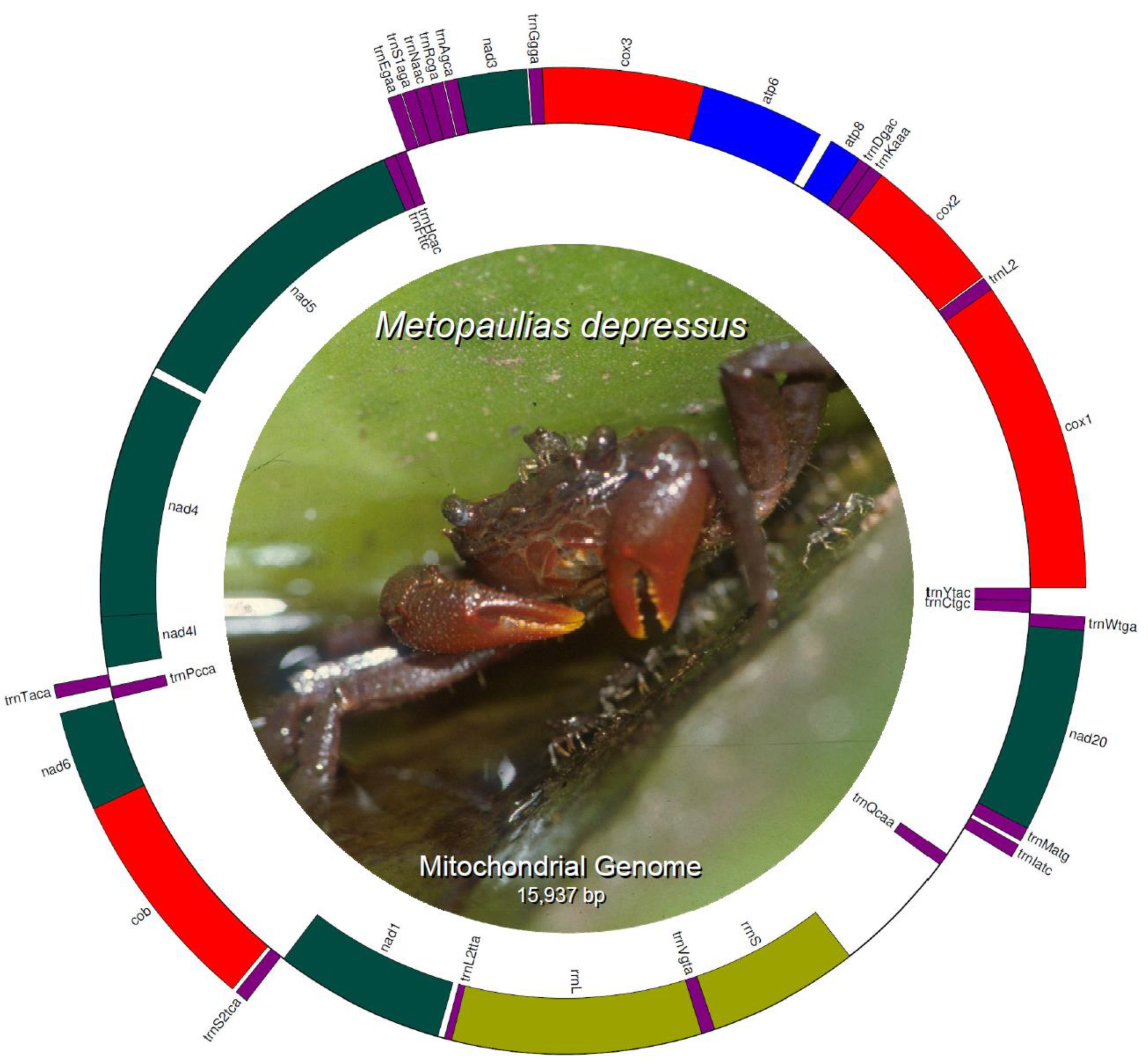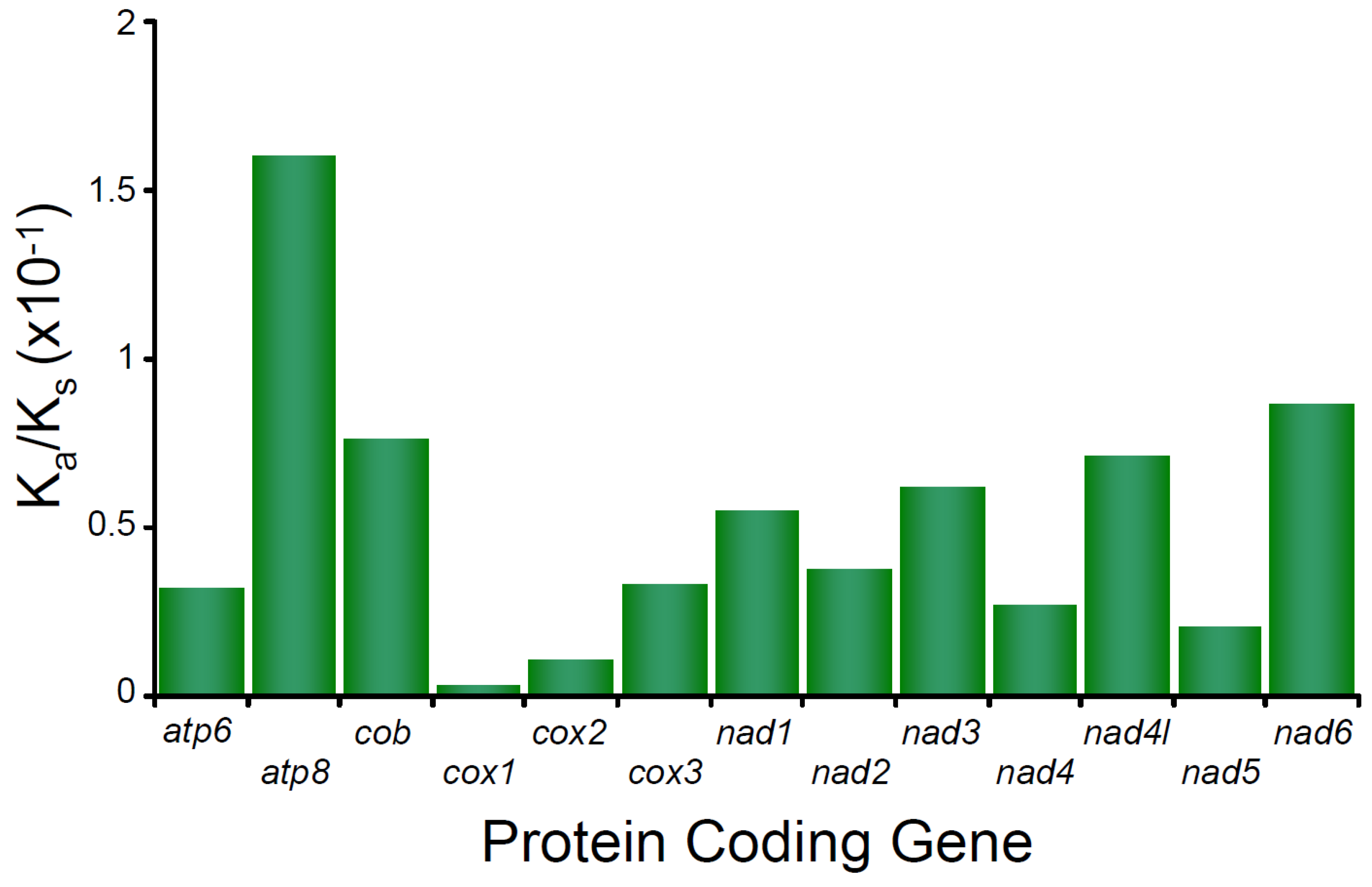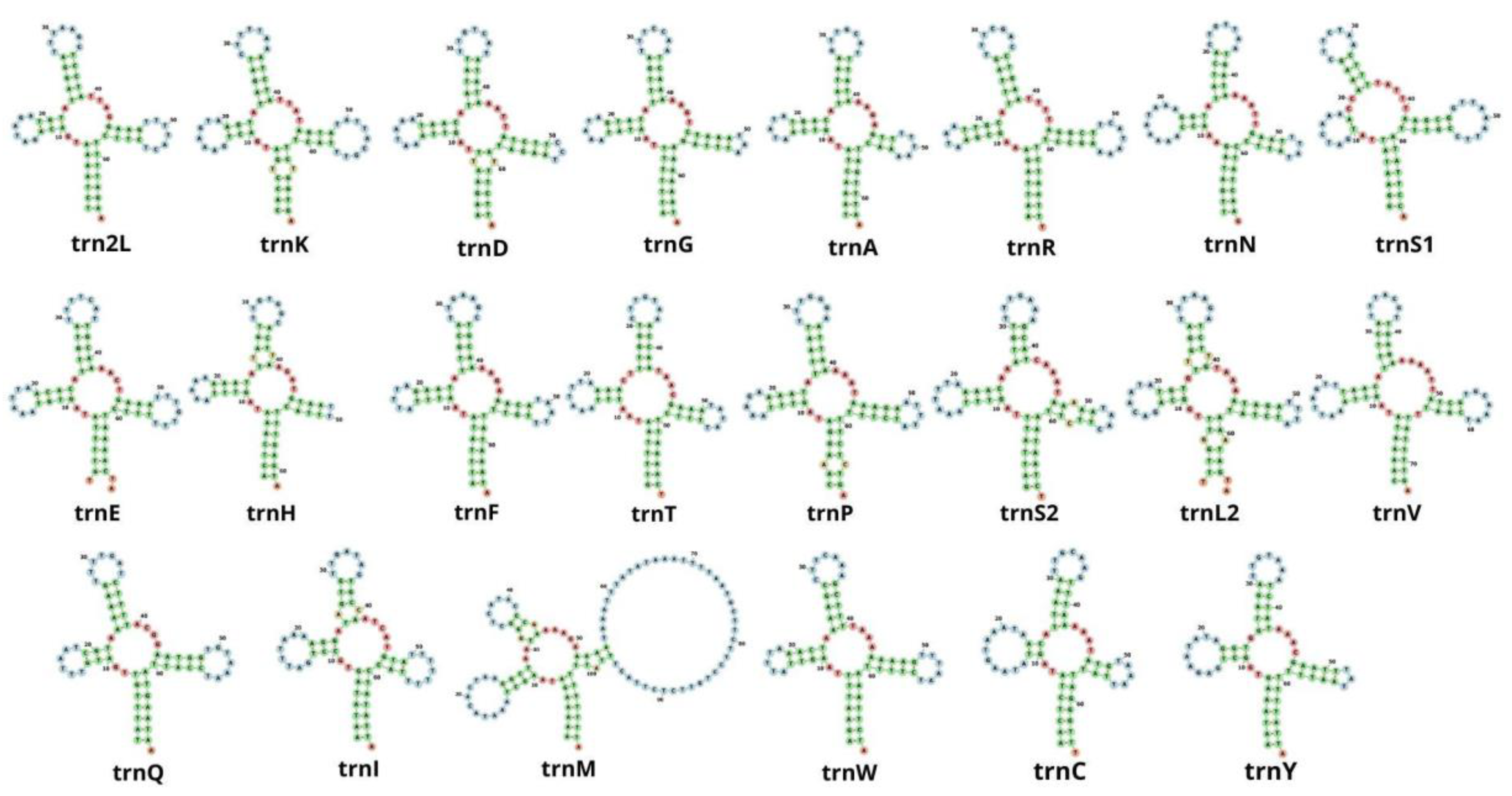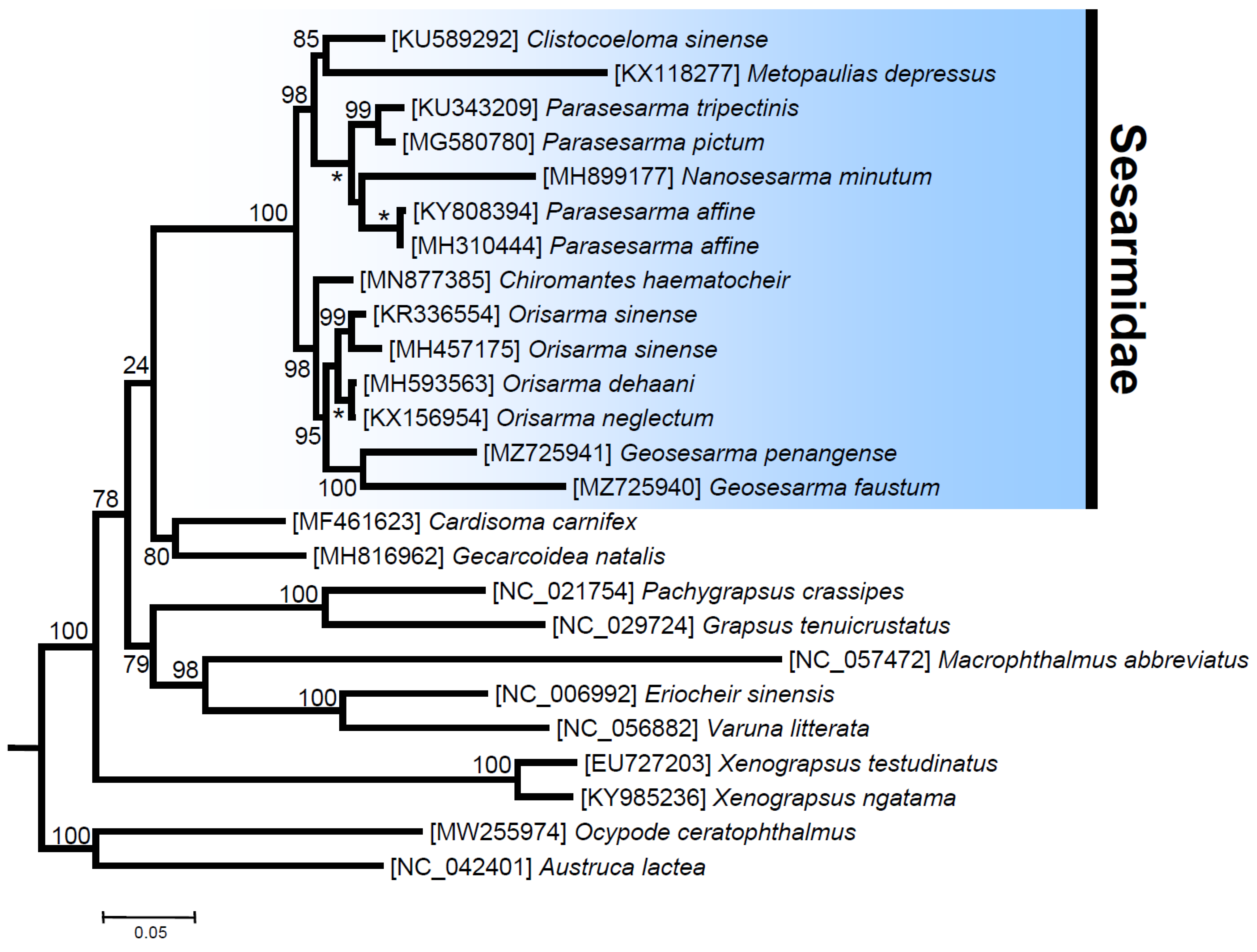Characterization of the Complete Mitochondrial Genome of the Bromeliad Crab Metopaulias depressus (Rathbun, 1896) (Crustacea: Decapoda: Brachyura: Sesarmidae)
Abstract
1. Introduction
2. Materials and Methods
2.1. Specimen Collection and Mitochondrial Genome Sequencing
2.2. Mitochondrial Genome Annotation and Characterization
2.3. Phylogenetic Position of Metopaulias Depressus
3. Results and Discussion
4. Conclusions
Supplementary Materials
Author Contributions
Funding
Institutional Review Board Statement
Informed Consent Statement
Data Availability Statement
Acknowledgments
Conflicts of Interest
References
- Martin, J.W.; Davis, G.E. An Updated Classification of the Recent Crustacea; Natural History Museum of L.A. County: Los Angeles, CA, USA, 2001; pp. 1–124. [Google Scholar]
- Davie, P.J. Crabs; Princeton University Press: Princeton, NJ, USA, 2022. [Google Scholar]
- Schubart, C.D.; Koller, P. Genetic diversity of freshwater crabs (Brachyura: Sesarmidae) from central Jamaica with description of a new species. J. Nat. Hist. 2005, 39, 469–481. [Google Scholar] [CrossRef]
- Diez, Y.L. Notes on the crabs of Cuba II: The family Sesarmidae (Decapoda, Brachyura) in the Oriental region. J. Mar. Res. 2018, 38, 159–167. [Google Scholar]
- Wang, Z.; Wang, Z.; Shi, X.; Wu, Q.; Tao, Y.; Guo, H.; Ji, C.; Bai, Y. Complete mitochondrial genome of Parasesarma affine (Brachyura: Sesarmidae): Gene rearrangements in Sesarmidae and phylogenetic analysis of the Brachyura. Int. J. Biol. Macromol. 2018, 118, 31–40. [Google Scholar] [CrossRef]
- Wang, Z.; Shi, X.; Tao, Y.; Wu, Q.; Bai, Y.; Guo, H.; Tang, D. The complete mitochondrial genome of Parasesarma pictum (Brachyura: Grapsoidea: Sesarmidae) and comparison with other Brachyuran crabs. Genomics 2019, 111, 799–807. [Google Scholar] [CrossRef]
- Diesel, R. Parental care in an unusual environment: Metopaulias depressus (Decapoda: Grapsidae), a crab that lives in epiphytic bromeliads. Anim. Behav. 1989, 38, 561–575. [Google Scholar] [CrossRef]
- Schubart, C.D.; Diesel, R.; Hedges, S.B. Rapid evolution to terrestrial life in Jamaican crabs. Nature 1998, 393, 363–365. [Google Scholar] [CrossRef]
- Diesel, R.; Schuh, M. Maternal care in the bromeliad crab, Metopaulias depressus: Maintaining oxygen, pH and calcium levels optimal for the larvae. Behav. Ecol. Sociobiol. 1993, 32, 11–15. [Google Scholar] [CrossRef]
- Diesel, R. Maternal control of calcium concentration in the larval nursery of the bromeliad crab, Metopaulias depressus (Grapsidae). Proc. R. Soc. Ldn. Ser. B Biol. Sci. 1997, 264, 1403–1406. [Google Scholar] [CrossRef]
- Diesel, R. Maternal care in the bromeliad crab, Metopaulias depressus: Protection of larvae from predation by damselfly nymphs. Anim. Behav. 1992, 43, 803–812. [Google Scholar] [CrossRef]
- Ng, P.K.L.; Tan, C.G.S. Geosesarma notophorum sp. nov. (Decapoda, Brachyura, Grapsidae, Sesarminae), a terrestrial crab from Sumatra, with novel brooding behaviour. Crustaceana 1995, 68, 390–395. [Google Scholar]
- Diesel, R.; Horst, D. Breeding in a snail shell: Ecology and biology of the Jamaican montane crab Sesarma jarvisi (Decapoda: Grapsidae). J. Crustac. Biol. 1995, 15, 179–195. [Google Scholar] [CrossRef]
- Little, E.E. Chemical communication of maternal behavior in crayfish. Nature 1975, 255, 400–401. [Google Scholar] [CrossRef]
- Little, E.E. Ontogeny of maternal behavior and brood pheromone in crayfish. J. Comp. Physiol. 1976, 112, 133–142. [Google Scholar] [CrossRef]
- Figler, M.H.; Grants, S.B.; Peeke, H.V.S. Maternal aggression and post-hatch care in red swamp crayfish, Procambarus clarkii (Girard): The influences of presence of offspring, fostering, and maternal molting. Mar. Freshw. Behav. Physiol. 1997, 30, 173–194. [Google Scholar] [CrossRef]
- Bechler, D.L. Copulatory and maternal offspring behavior in the hypogean crayfish Orconectes inermis inermis Cope and Orconectes pellucidus (Tell Kampf) (Decapoda, Astacidea). Crustaceana 1981, 40, 136–143. [Google Scholar] [CrossRef]
- Hazlett, B.A. Parental Behavior in Decapod Crustacea. In Studies in Adaptation: The Behavior of Higher Crustacea; Rebach, S., Dunham, D.W., Eds.; John Wiley & Sons: New York, NY, USA, 1983; pp. 171–193. [Google Scholar]
- Leese, F.; Brand, P.; Rozenberg, A.; Mayer, C.; Agrawal, S.; Dambach, J.; Dietz, L.; Doemel, J.S.; Goodall-Copstake, W.P.; Held, C.; et al. Exploring Pandora’s box: Potential and pitfalls of low coverage genome surveys for evolutionary biology. PLoS ONE 2012, 7, e49202. [Google Scholar] [CrossRef][Green Version]
- Rozenberg, A.; Brand, P.; Rivera, N.; Leese, F.; Schubart, C.D. Characterization of fossilized relatives of the White Spot Syndrome Virus in genomes of decapod crustaceans. BMC Evol. Biol. 2015, 15, 142. [Google Scholar] [CrossRef]
- Ng, P.K.L.; Guinot, D.; Davie, P. Systema Brachyurorum: Part I. An annotated checklist of extant Brachyuran crabs of the world. Raffles Bull. Zool. 2008, 17, 1–296. [Google Scholar]
- Schubart, C.D.; Cuesta, J.A.; Felder, D.L. Glyptograpsidae, a new brachyuran family from Central America: Larval and adult morphology, and a molecular phylogeny of the Grapsoidea. J. Crustacean Biol. 2002, 22, 28–44. [Google Scholar] [CrossRef]
- Kitaura, J.; Wada, K.; Nishida, M. Molecular phylogeny of grapsoid and ocypodoid crabs with special reference to the genera Metaplax and Macrophthalmus. J. Crustac. Biol. 2002, 22, 682–693. [Google Scholar] [CrossRef]
- Schubart, C.D.; Cannicci, S.; Vannini, M.; Fratini, S. Molecular phylogeny of grapsoid crabs (Decapoda, Brachyura) and allies based on two mitochondrial genes and a proposal for refraining from current superfamily classification. J. Zool. Syst. Evol. Res. 2006, 44, 193–199. [Google Scholar] [CrossRef]
- Tsang, L.M.; Schubart, C.D.; Ahyong, S.T.; Lai, J.C.Y.; Au, E.; Chan, T.Y.; Ng, P.K.L.; Chu, K.H. Evolutionary history of true crabs (Crustacea: Decapoda: Brachyura) and the origins of freshwater crabs. Mol. Biol. Evol. 2014, 31, 1173–1187. [Google Scholar] [CrossRef] [PubMed]
- Yamauchi, M.M.; Miya, M.U.; Machida, R.J.; Nishida, M. PCR-based approach for sequencing mitochondrial genomes of decapod crustaceans, with a practical example from kuruma prawn (Marsupenaeus japonicus). Mar. Biotechnol. 2004, 6, 419–429. [Google Scholar] [CrossRef] [PubMed]
- Bernt, M.; Donath, A.; Jühling, F.; Externbrink, F.; Florentz, C.; Fritzsch, G.; Pütz, J.; Middendorf, M.; Stadler, P.F. Improved de novo metazoan mitochondrial genome annotation. Mol. Phylogen. Evol. 2013, 69, 313–319. [Google Scholar] [CrossRef]
- Donath, A.; Jühling, F.; Al-Ara, M.; Bernhart, S.H.; Reinhardt, F.; Stadler, P.F.; Middendorf, M.; Bernt, M. Improved annotation of protein-coding genes boundaries in metazoan mitochondrial genomes. Nucleic Acids Res. 2019, 47, 10543–10552. [Google Scholar] [CrossRef]
- Gasteiger, E.; Gattiker, A.; Hoogland, C.; Ivanyi, I.; Appel, R.D.; Bairoch, A. ExPASy: The proteomics server for in-depth protein knowledge and analysis. Nucleic Acids Res. 2003, 31, 3784–3788. [Google Scholar] [CrossRef]
- Kumar, S.; Stecher, G.; Tamura, K. MEGA7: Molecular evolutionary genetics analysis version 7.0 for bigger datasets. Mol. Biol. Evol. 2016, 33, 1870–1874. [Google Scholar] [CrossRef]
- Conant, G.C.; Wolfe, K.H. GenomeVx: Simple web-based creation of editable circular chromosome maps. Bioinformatics 2007, 24, 861–862. [Google Scholar] [CrossRef]
- Stothard, P. The Sequence Manipulation Suite: JavaScript programs for analyzing and formatting protein and DNA sequences. Biotechniques 2000, 28, 1102–1104. [Google Scholar] [CrossRef]
- Lee, B.D. Python implementation of codon adaptation index. J. Open Source Softw. 2018, 3, 905. [Google Scholar] [CrossRef]
- Conrad, I.; Craft, A.; Thurman, C.L.; Baeza, J.A. The complete mitochondrial genome of the red-jointed brackish-water fiddler crab Minuca minax (LeConte 1855) (Brachyura: Ocypodidae): New family gene order, and purifying selection and phylogenetic informativeness of protein coding genes. Genomics 2021, 11, 565–572. [Google Scholar] [CrossRef]
- Jühling, F.; Püt, J.; Bernt, M.; Donath, A.; Middendorf, M.; Florentz, C.; Stadler, P.F. Improved systematic tRNA gene annotation allows new insights into the evolution of mitochondrial tRNA structures and into the mechanisms of mitochondrial genome rearrangements. Nucleic Acids Res. 2012, 40, 2833–2845. [Google Scholar] [CrossRef] [PubMed]
- Kerpedjiev, P.; Hammer, S.; Hofacker, I.L. Forna (force-directed RNA): Simple and effective online RNA secondary structure diagrams. Bioinformatics 2015, 31, 3377–3379. [Google Scholar] [CrossRef] [PubMed]
- Bikandi, J.; San Millán, R.; Rementeria, A.; Garaizar, J. In silico analysis of complete bacterial genomes: PCR, AFLP-PCR, and endonuclease restriction. Bioinformatics 2004, 20, 798–799. [Google Scholar] [CrossRef] [PubMed]
- Benson, G. Tandem repeats finder: A program to analyze DNA sequences. Nucleic Acids Res. 1999, 27, 573–580. [Google Scholar] [CrossRef]
- Reuter, J.S.; Mathews, D.H. RNAstructure: Software for RNA secondary structure prediction and analysis. BMC Bioinform. 2010, 11, 129. [Google Scholar] [CrossRef]
- Tan, M.H.; Gan, H.; Schultz, M.B.; Austin, C.M. MitoPhAST, a new automated mitogenomic phylogeny tool in the post-genomic era with a case study of 89 decapod mitogenomes including eight new freshwater crayfish mitogenomes. Mol. Phylogenet. Evol. 2015, 85, 180–188. [Google Scholar] [CrossRef]
- Siervers, F.; Wilm, A.; Dineen, D.; Gibson, T.J.; Karplus, K.; Li, W.; Lopez, R.; McWilliam, H.; Remmert, M.; Söding, J.; et al. Fast, scalable generation of high-quality protein multiple sequence alignments using Clustal Omega. Mol. Syst. Biol. 2011, 7, 539. [Google Scholar] [CrossRef]
- Sievers, F.; Higgins, D.G. Clustal Omega for making accurate alignments of many protein sequences. Protein Sci. 2018, 27, 135–145. [Google Scholar] [CrossRef]
- Capella-Gutiérrez, S.; Silla-Martínez, J.M.; Gabaldón, T. trimAl: A tool for automated alignment trimming in large-scale phylogenetic analyses. Bioinformatics 2009, 25, 1972–1973. [Google Scholar] [CrossRef]
- Darriba, D.; Taboada, G.L.; Doallo, R.; Posada, D. ProtTest 3: Fast selection of best-fit models of protein evolution. Bioinformatics 2011, 27, 1164–1165. [Google Scholar] [CrossRef]
- Nguyen, L.T.; Schmidt, H.A.; von Haeseler, A.; Minh, B.Q. IQ-TREE: A fast and effective stochastic algorithm for estimating maximum-likelihood phylogenies. Mol. Biol. Evol. 2015, 32, 268–274. [Google Scholar] [CrossRef] [PubMed]
- Lau, N.S.; Sam, K.K.; Ahmad, A.B.; Siti, K.A.; Abdul Wahab, A.Z.; Shu-Chien, A.C. Gene arrangement and adaptive evolution in the mitochondrial genomes of terrestrial sesarmid crabs Geosesarma faustum and Geosesarma penangensis. Front. Ecol. Evol. 2021, 9, 778570. [Google Scholar] [CrossRef]
- Xing, Y.; Ma, X.; Wei, Y.; Pan, D.; Liu, W.; Sun, H. The complete mitochondrial genome of the semiterrestrial crab, Chiromantes neglectum (Eubrachyura: Grapsoidea: Sesarmidae). Mitochondrial DNA B 2016, 1, 461–463. [Google Scholar] [CrossRef] [PubMed]
- Tang, B.P.; Xin, Z.Z.; Liu, Y.; Zhang, D.Z.; Wang, Z.F.; Zhang, H.B.; Chai, X.Y.; Zhou, C.L.; Liu, Q.N. The complete mitochondrial genome of Sesarmops sinensis reveals gene rearrangements and phylogenetic relationships in Brachyura. PLoS ONE 2017, 12, e0179800. [Google Scholar] [CrossRef] [PubMed]
- Li, Y.T.; Xin, Z.Z.; Tang, Y.Y.; Yang, T.T.; Tang, B.P.; Sun, Y.; Zhang, D.Z.; Zhou, C.L.; Liu, Q.N.; Yu, X.M. Comparative mitochondrial genome analyses of sesarmid and other brachyuran crabs reveal gene rearrangements and phylogeny. Front. Genet. 2020, 11, 536640. [Google Scholar] [CrossRef]
- Park, Y.J.; Park, C.E.; Lee, S.H.; Sook Ko, H.; Ullah, I.; Hwang, U.W.; Shin, J.H. The complete mitochondrial genome sequence of the intertidal crab Parasesarma tripectinis (Arthropoda, Decapoda, Sesarmidae). Mitochondrial DNA B 2018, 3, 193–194. [Google Scholar] [CrossRef]
- Zhang, Y.; Gao, Y.; Gong, L.; Lu, X.; Jiang, L.; Liu, B.; Liu, L.; Lü, Z.; Li, P. Mitochondrial Genome of Episesarma lafondii (Brachyura: Sesarmidae) and Comparison with Other Sesarmid Crabs. J. Ocean Univ. China 2021, 20, 1545–1556. [Google Scholar] [CrossRef]
- Gan, H.Y.; Gan, H.M.; Tan, M.H.; Lee, Y.P.; Austin, C.M. The complete mitogenome of the hermit crab Clibanarius infraspinatus (Hilgendorf, 1869), (Crustacea; Decapoda; Diogenidae)—A new gene order for the Decapoda. Mitochondrial DNA A 2016, 27, 4099–4100. [Google Scholar] [CrossRef]
- Yang, J.S.; Nagasawa, H.; Fujiwara, Y.; Tsuchida, S.; Yang, W.J. The complete mitogenome of the hydrothermal vent crab Gandalfus yunohana (Crustacea: Decapoda: Brachyura): A link between the Bythograeoidea and Xanthoidea. Zool. Scr. 2010, 39, 621–630. [Google Scholar] [CrossRef]
- Baeza, J.A. The complete mitochondrial genome of the Caribbean spiny lobster Panulirus argus. Sci. Rep. 2018, 8, 1–10. [Google Scholar] [CrossRef] [PubMed]
- Chak, T.C.; Baeza, J.A.; Barden, P. Eusociality shapes convergent patterns of molecular evolution across mitochondrial genomes of snapping shrimps. Mol. Biol. Evol. 2021, 38, 1372–1383. [Google Scholar] [CrossRef] [PubMed]
- Kilpert, F.; Podsiadlowski, L. The Australian freshwater isopod (Phreatoicidea: Isopoda) allows insights into the early mitogenomic evolution of isopods. Comp. Biochem. Physiol.-D Genom. Proteom. 2010, 5, 36–44. [Google Scholar]
- Li, Q.; Xu, C.; Wang, C.; Liu, G. The complete mitochondrial genome of red-clawed crab Chiromantes haematochir (Sesarmidae: Grapsidae). Mitochondrial DNA B 2019, 4, 53–54. [Google Scholar] [CrossRef]
- Xin, Z.Z.; Liu, Y.; Zhang, D.Z.; Chai, X.Y.; Wang, Z.F.; Zhang, H.B.; Zou, C.L.; Tang, B.P.; Liu, Q.N. Complete mitochondrial genome of Clistocoeloma sinensis (Brachyura: Grapsoidea): Gene rearrangements and higher-level phylogeny of the Brachyura. Sci. Rep. 2017, 7, 1–10. [Google Scholar] [CrossRef] [PubMed]
- Geng, X.; Cheng, R.; Xiang, T.; Deng, B.; Wang, Y.; Deng, D.; Zhang, H. The complete mitochondrial genome of the Chinese Daphnia pulex (Cladocera, Daphniidae). Zookeys 2016, 615, 47–60. [Google Scholar]
- Schubart, C.D.; Ng, P.K.L. Revision of the intertidal and semiterrestrial crab genera Chiromantes Gistel, 1848, and Pseudosesarma Serène & Soh, 1970 (Crustacea: Brachyura: Sesarmidae), using morphology and molecular phylogenetics, with the establishment of nine new genera and two new species. Raffles Bull. Zool. 2020, 68, 891–994. [Google Scholar]





| Name | Type | Start | Stop | Strand | Length (bp) | Start | Stop | Anticodon | Continuity |
|---|---|---|---|---|---|---|---|---|---|
| cox1 | pcg | 1 | 1560 | + | 1560 | ATG | TAG | −25 | |
| trnL2 | tRNA | 1536 | 1601 | + | 66 | TAA | +8 | ||
| cox2 | pcg | 1610 | 2317 | + | 708 | ATG | TAA | −20 | |
| trnK(aaa) | tRNA | 2298 | 2366 | + | 69 | TTT | +1 | ||
| trnD(gac) | tRNA | 2368 | 2433 | + | 66 | GTC | 0 | ||
| atp8 | pcg | 2434 | 2592 | + | 159 | ATG | TAA | +59 | |
| atp6 | pcg | 2652 | 3260 | + | 609 | ATT | TAA | −1 | |
| cox3 | pcg | 3260 | 4051 | + | 792 | ATG | TAA | 0 | |
| trnG(gga) | tRNA | 4052 | 4116 | + | 65 | TCC | +9 | ||
| nad3 | pcg | 4126 | 4464 | + | 340 | ATA | T | +1 | |
| trnA(gca) | tRNA | 4466 | 4528 | + | 63 | TGC | +6 | ||
| trnR(cga) | tRNA | 4535 | 4602 | + | 67 | TCG | +2 | ||
| trnN(aac) | tRNA | 4605 | 4671 | + | 67 | GTT | +2 | ||
| trnS1(aga) | tRNA | 4674 | 4740 | + | 67 | TCT | +5 | ||
| trnE(gaa) | tRNA | 4746 | 4813 | + | 68 | TTC | +3 | ||
| trnH(cac) | tRNA | 4817 | 4878 | − | 62 | GTG | +1 | ||
| trnF(ttc) | tRNA | 4880 | 4944 | − | 65 | GAA | 0 | ||
| nad5 | pcg | 4945 | 6639 | − | 1695 | ATA | TAA | +51 | |
| nad4 | pcg | 6691 | 8043 | − | 1353 | ATG | TAA | −7 | |
| nad4l | pcg | 8037 | 8312 | − | 276 | ATA | TAA | +37 | |
| trnT(aca) | tRNA | 8350 | 8416 | + | 67 | TGT | 0 | ||
| trnP(cca) | tRNA | 8417 | 8483 | − | 67 | TGG | +8 | ||
| nad6 | pcg | 8492 | 8980 | + | 489 | ATA | TAA | 0 | |
| cob | pcg | 8980 | 10,084 | + | 1105 | ATG | T | +21 | |
| trnS2(tca) | tRNA | 10,106 | 10,173 | + | 68 | TGA | +19 | ||
| nad1 | pcg | 10,193 | 11,128 | − | 936 | ATA | TAA | +36 | |
| trnL2(tta) | tRNA | 11,165 | 11,235 | − | 71 | TAA | −29 | ||
| rrnL | rib | 11,206 | 12,574 | − | 1369 | 0 | |||
| trnV(gta) | tRNA | 12,575 | 12,647 | − | 73 | TAC | 0 | ||
| rrnS | rib | 12,648 | 13,479 | − | 832 | 0 | |||
| CR | 13,480 | 14,170 | 691 | 0 | |||||
| trnQ(caa) | tRNA | 14,171 | 14,238 | − | 68 | TTG | +168 | ||
| trnI(atc) | tRNA | 14,407 | 14,473 | + | 67 | GAT | +21 | ||
| trnM(atg) | tRNA | 14,495 | 14,569 | + | 75 | CAT | −6 | ||
| nad2 | pcg | 14,564 | 15,562 | + | 999 | ATG | TAG | −2 | |
| trnW(tga) | tRNA | 15,561 | 15,628 | + | 68 | TCA | +5 | ||
| trnC(tgc) | tRNA | 15,634 | 15,698 | − | 65 | GCA | 0 | ||
| trnY(tac) | tRNA | 15,699 | 15,765 | − | 67 | GTA | 0 |
Publisher’s Note: MDPI stays neutral with regard to jurisdictional claims in published maps and institutional affiliations. |
© 2022 by the authors. Licensee MDPI, Basel, Switzerland. This article is an open access article distributed under the terms and conditions of the Creative Commons Attribution (CC BY) license (https://creativecommons.org/licenses/by/4.0/).
Share and Cite
Rodriguez-Pilco, M.A.; Leśny, P.; Podsiadłowski, L.; Schubart, C.D.; Baeza, J.A. Characterization of the Complete Mitochondrial Genome of the Bromeliad Crab Metopaulias depressus (Rathbun, 1896) (Crustacea: Decapoda: Brachyura: Sesarmidae). Genes 2022, 13, 299. https://doi.org/10.3390/genes13020299
Rodriguez-Pilco MA, Leśny P, Podsiadłowski L, Schubart CD, Baeza JA. Characterization of the Complete Mitochondrial Genome of the Bromeliad Crab Metopaulias depressus (Rathbun, 1896) (Crustacea: Decapoda: Brachyura: Sesarmidae). Genes. 2022; 13(2):299. https://doi.org/10.3390/genes13020299
Chicago/Turabian StyleRodriguez-Pilco, Milena A., Peter Leśny, Lars Podsiadłowski, Christoph D. Schubart, and Juan Antonio Baeza. 2022. "Characterization of the Complete Mitochondrial Genome of the Bromeliad Crab Metopaulias depressus (Rathbun, 1896) (Crustacea: Decapoda: Brachyura: Sesarmidae)" Genes 13, no. 2: 299. https://doi.org/10.3390/genes13020299
APA StyleRodriguez-Pilco, M. A., Leśny, P., Podsiadłowski, L., Schubart, C. D., & Baeza, J. A. (2022). Characterization of the Complete Mitochondrial Genome of the Bromeliad Crab Metopaulias depressus (Rathbun, 1896) (Crustacea: Decapoda: Brachyura: Sesarmidae). Genes, 13(2), 299. https://doi.org/10.3390/genes13020299







